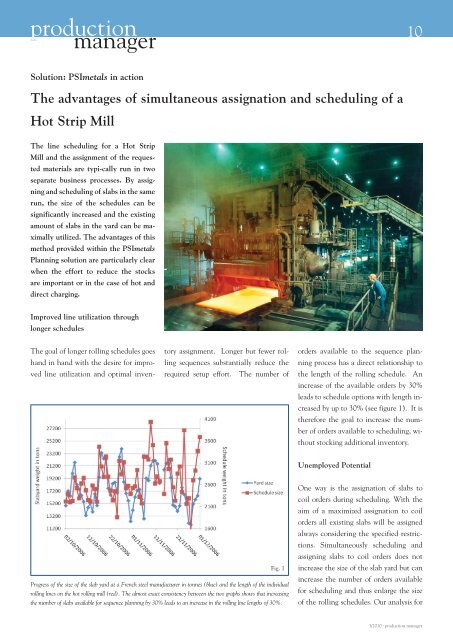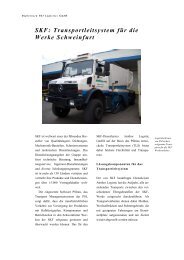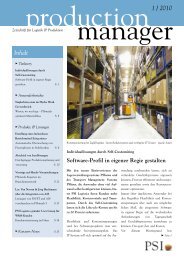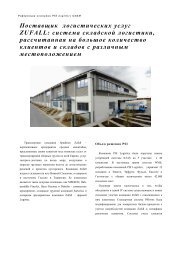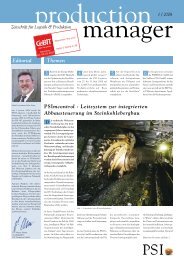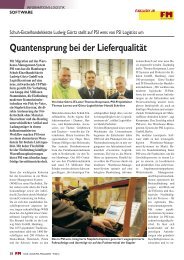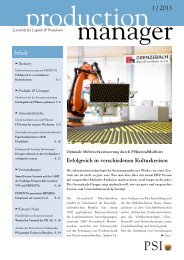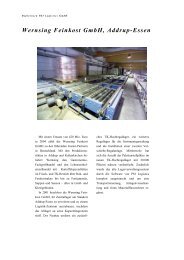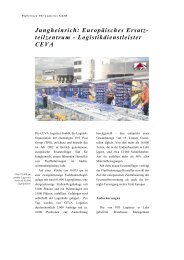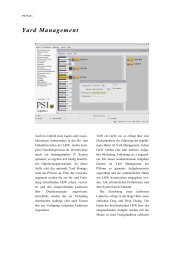production manager 3-2010 - PSI Metals
production manager 3-2010 - PSI Metals
production manager 3-2010 - PSI Metals
You also want an ePaper? Increase the reach of your titles
YUMPU automatically turns print PDFs into web optimized ePapers that Google loves.
p<strong>production</strong> 10<br />
<strong>manager</strong><br />
Solution: <strong>PSI</strong>metals in action<br />
The advantages of simultaneous assignation and scheduling of a<br />
Hot Strip Mill<br />
The line scheduling for a Hot Strip<br />
Mill and the assignment of the reques-<br />
ted materials are typi-cally run in two<br />
separate business processes. By assig-<br />
ning and scheduling of slabs in the same<br />
run, the size of the schedules can be<br />
significantly increased and the existing<br />
amount of slabs in the yard can be ma-<br />
ximally utilized. The advantages of this<br />
method provided within the <strong>PSI</strong>metals<br />
Planning solution are particularly clear<br />
when the effort to reduce the stocks<br />
are important or in the case of hot and<br />
direct charging.<br />
Improved line utilization through<br />
longer schedules<br />
The goal of longer rolling schedules goes<br />
hand in hand with the desire for impro-<br />
ved line utilization and optimal inven-<br />
tory assignment. Longer but fewer rol-<br />
ling sequences substantially reduce the<br />
required setup effort. The number of<br />
Fig. 1<br />
Progress of the size of the slab yard at a French steel manufacturer in tonnes (blue) and the length of the individual<br />
rolling lines on the hot rolling mill (red). The almost exact consistency between the two graphs shows that increasing<br />
the number of slabs available for sequence planning by 30% leads to an increase in the rolling line lengths of 30%.<br />
orders available to the sequence plan-<br />
ning process has a direct relationship to<br />
the length of the rolling schedule. An<br />
increase of the available orders by 30%<br />
leads to schedule options with length in-<br />
creased by up to 30% (see figure 1). It is<br />
therefore the goal to increase the num-<br />
ber of orders available to scheduling, wi-<br />
thout stocking additional inventory.<br />
Unemployed Potential<br />
One way is the assignation of slabs to<br />
coil orders during scheduling. With the<br />
aim of a maximized assignation to coil<br />
orders all existing slabs will be assigned<br />
always considering the specified restric-<br />
tions. Simultaneously scheduling and<br />
assigning slabs to coil orders does not<br />
increase the size of the slab yard but can<br />
increase the number of orders available<br />
for scheduling and thus enlarge the size<br />
of the rolling schedules. Our analysis for<br />
3/<strong>2010</strong> ∙ <strong>production</strong> <strong>manager</strong>


